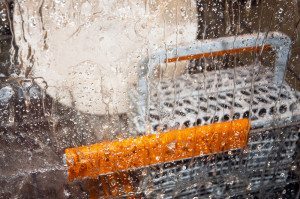Your dishwasher is somewhat of a modern marvel. For home chefs and busy families alike, the beauty of the dishwasher is how quickly and efficiently it cleans and how uncomplicated it is to operate. Simply load the dishes, add the detergent, and after just a short time, Voila! Clean dishes. But has your inner kitchen geek ever wondered about the science behind those clean dishes? Miracles of physics and biology take dirty dishes caked with baked-on food debris from gunky to gleaming. Following is a look at the inner world of your dishwasher.
operate. Simply load the dishes, add the detergent, and after just a short time, Voila! Clean dishes. But has your inner kitchen geek ever wondered about the science behind those clean dishes? Miracles of physics and biology take dirty dishes caked with baked-on food debris from gunky to gleaming. Following is a look at the inner world of your dishwasher.
Getting Your Dishes Clean and Shiny
The basic job of dishwasher detergents is to get rid of the food debris and grime from the surface of dishes, glasses, pots, pans and silverware. It must also stop the dirt from re-depositing itself on these implements during the remaining cleaning cycle.
Dishwashing detergents use six main components to keep your dishes sparkling:
- Alkalis, which control the pH of the detergent and help get rid of dirt
- Builders, which handle minerals that make water hard and prevent lime scale deposits from forming
- Bleaching systems, which oxidize certain types of food residue like tea and coffee stains, making them easier to wash away
- Enzymes, which act as catalysts for the other cleaning agents
- Protease, which helps get rid of stains (such as egg) that have a protein base
- Amylase, which handles residue from starches like oatmeal and potato
Whether you use powder, gel or pods, all of these grime fighters are part of your dishwasher’s arsenal against dirty dishes. But it doesn’t stop there. Rinse agents make sure that your dishes aren’t just clean, but that they shine and sparkle as well as dry faster.
The two main ingredients that the rinse agents use are:
- Non-ionic surfactants, which chemically change drops of water into a thin layer of water. This makes all your dishes, pans and glassware dry faster.
- Polymers, which are responsible for shiny surfaces
The Science of Loading Your Dishwasher
Now that you know the physics of cleaning, you can learn how to properly load your dishwasher to make the best use of all those chemicals. Engineers and researchers at the University of Birmingham studied how water moves inside both empty and full dishwashers. Their findings tell us the best spots to place very dirty and more lightly soiled items to make best use of the cleaning mechanisms of your dishwasher. Their suggestions include the following.
- Place your dishes in a circular pattern to make sure they get fully hit by the dishwasher’s jet spraying patterns.
- Really dirty items, whether dishes or pans, get the full force of your dishwasher’s water jets if you place them just above the rotator arm and in the center of the top shelf.
- Don’t cram the dishes together. This prevents water from spraying all the surface areas.
As you pull your gleaming plates and sparkling glassware out for another meal, give a nod of acknowledgment to the scientific know-how and chemical reactions in your dishwasher that make it all possible.
Your dishwasher’s cleaning mechanisms are highly effective and reliable, so if your dishes aren’t coming clean, the machine may need a little professional love and attention. Contact Complete Appliance Repair in northern Utah to schedule a maintenance inspection and repair service. Their experienced professional technicians will have your dishwasher running as good as new in no time.

